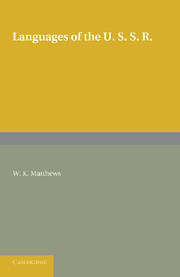Book contents
- Frontmatter
- Contents
- LIST OF ILLUSTRATIONS
- PREFACE
- Map
- Chapter I THE LINGUISTIC PATTERN
- Chapter II PALAEOASIATIG LANGUAGES
- Chapter III URALIAN LANGUAGES
- Chapter IV ALTAIC LANGUAGES
- Chapter V NORTH CAUCASIAN LANGUAGES
- Chapter VI SOUTH CAUCASIAN LANGUAGES
- Chapter VII INDO-EUROPEAN LANGUAGES
- Appendix I TABULAR SUMMARY
- Appendix II LANGUAGE STATISTICS
- Appendix III BIBLIOGRAPHY
- Appendix VI INDEX OF LANGUAGES AND DIALECTS
- Appendix V SYMBOLS AND PHONETIC VALUES
- INDEX
Chapter VII - INDO-EUROPEAN LANGUAGES
Published online by Cambridge University Press: 05 June 2016
- Frontmatter
- Contents
- LIST OF ILLUSTRATIONS
- PREFACE
- Map
- Chapter I THE LINGUISTIC PATTERN
- Chapter II PALAEOASIATIG LANGUAGES
- Chapter III URALIAN LANGUAGES
- Chapter IV ALTAIC LANGUAGES
- Chapter V NORTH CAUCASIAN LANGUAGES
- Chapter VI SOUTH CAUCASIAN LANGUAGES
- Chapter VII INDO-EUROPEAN LANGUAGES
- Appendix I TABULAR SUMMARY
- Appendix II LANGUAGE STATISTICS
- Appendix III BIBLIOGRAPHY
- Appendix VI INDEX OF LANGUAGES AND DIALECTS
- Appendix V SYMBOLS AND PHONETIC VALUES
- INDEX
Summary
Immediately flanking Georgian on the north is Ossetic, the language of the North Ossete Autonomous Republic (capital Dzaujikau, formerly Vladikavkaz) and of the South Ossete Autonomous Province (capital Stalinir, formerly Tskhinval) in Georgia, which bestride the central Caucasus range, and flanking it on the south is Armenian, which is now largely concentrated in the Armenian Federal Republic (capital Erevan). Both Ossetic, with over 350,000 speakers, and Armenian, with over two millions, are Indo-European languages : Ossetic is a member of the Iranic branch and cognate with Persian and its dialects Talysh and Tat, which are spoken in Soviet Azerbaijan, as well as with Tajiki and the Pamiri dialects of the federal republic of Tajikistan (capital Stalinabad, formerly Dyushambe); Armenian stands isolated, like the Albanian, Hellenic, and Tokharian branches of Indo-European.
The connection of Ossetic (Os, Ir) with the language of the ancient Alans, a Sarmatian tribe mentioned in the sixth century by Jordanes, may be demonstrated circuitously by adducing the vocabulary it shares with Hungarian. It is well known that the Hungarians and the Alans were medieval neighbours and allies before the former finally migrated to and settled down in Slavonic Pannonia, i.e. the major Danubian plain. And the name ‘Alan’ has been equated with ‘Ārya’ and with the Ossetic ‘Ir’.
Ossetic resembles the geographically eastern types of Iranic, especially Sogdian and its modern descendant Yaghnobi, and displays a Caucasian taste for consonantal groupings, though these are not nearly so complex as in North and South Caucasian because of the presence of alleviating vowels. The chief dialectal, mainly phonetic differences are between West Ossetic (Digor) and East Ossetic (Tagaur), which is numerically the more important of the two and the basis of the literary language. The vowel system of both dialects is of a conservative Indo- European type, with front rounded vowels absent altogether. Length is a ‘suprasegmental’ phoneme and occurs in diphthongs as well as in pure vowels (e.g. ūi/ui and ī/i). The consonantal system contains uvulars (e.g. q) and has absorbed ‘ Caucasian’ ejectives, or ‘abruptives' (p', t', k',ts',tš'). Unlike the other Iranic languages which have mostly simplified their system of declension, Ossetic, as between its dialects, retains eight cases, including an interior and an exterior locative and a sociative (in Tagaur), and ekes these out with a large number of prepositions and postpositions.
- Type
- Chapter
- Information
- Languages of the USSR , pp. 102 - 121Publisher: Cambridge University PressPrint publication year: 2013



